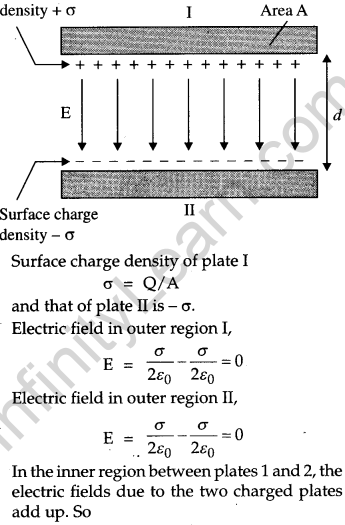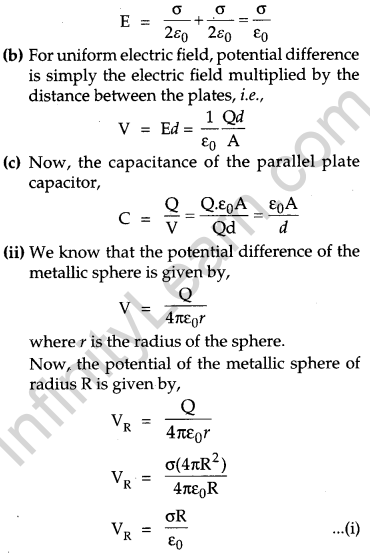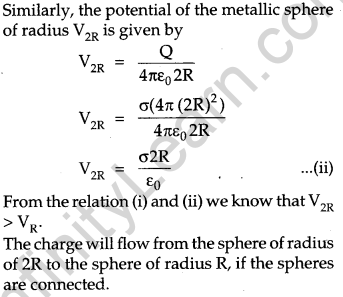CBSE Previous Year Question Papers Class 12 Physics 2016 Outside Delhi
Section — A
Question 1.
A charge ‘q’ is moved from a point A above a dipole of dipole moment ‘p’ to a point B below the dipole in equatorial plane without acceleration. Find the work done in the process. [1]
Answer:
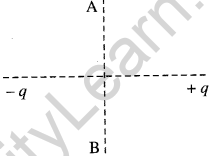
Work done, W = q(VB – VA ) = q × 0 = 0
Question 2.
In what way is the behavior of a diamagnetic material different from that of a para magnetic, when kept in an external magnetic field ? [1]
Answer:
The magnetic field lines pass through the para magnetic material while the magnetic field lines move away from the diamagnetic material, or para magnetic material get aligned along B and dianegnetic aliqied perpendicular to B.
Question 3.
Name the essential components of a communication system. [1]
Answer :
The essential components are : Transmitter, communication channel and receiver.
Question 4.
Why does sun appear red at sunrise and sunset? [1]
Answer :
Sun appears red at sunrise and sunset due to the least scattering of red light as it has the longest wavelength.
Question 5.
The plot of the variation of potential difference across a combination of three identical cells in series, versus current is shown below. What is the emf and internal resistance of each cell ? [1]

Answer:
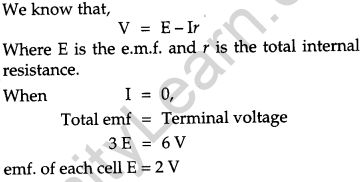
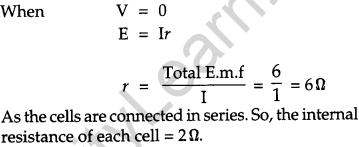
Section—B
Question 6.
Define modulation index. Why is it kept low ? What is the role of a band pass filter ? [2]
Question 7.
A ray PQ incident normally on the refracting face BA is refracted in the prism BAC made of material of refractive index 1.5. Complete the path of ray through the prism. From which face will the ray emerge ? Justify your answer. [2]
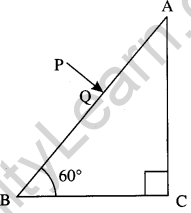
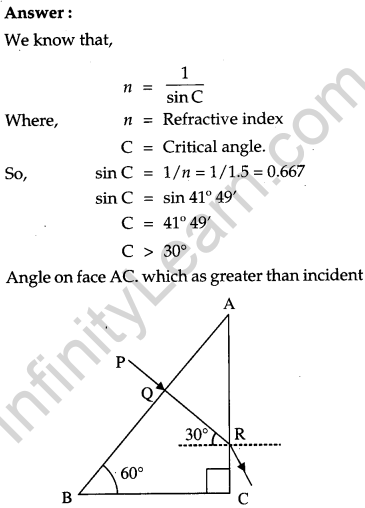
Thus, the light ray PQ will emergy out from face AC.
Question 8.
Calculate the de-Broglie wavelength of the electron orbiting in the n = 2 stage of hydrogen atom. [2]
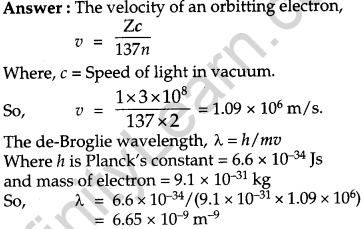
Question 9.
Define ionization energy.
How would the ionization energy change when electron in hydrogen atom replaced by a particle of mass 200 times that of the electron but having the same charge ? [2]
OR
Calculate the shortest wavelength of the spectral lines emitted in Balmer series. [Given Rydberg constant, R= 107 m-1]
Answer :
Ionization energy is defined as the amount of energy needed to remove the valence electron of an isolated gaseous atom.
The ionization energy of hydrogen atom is
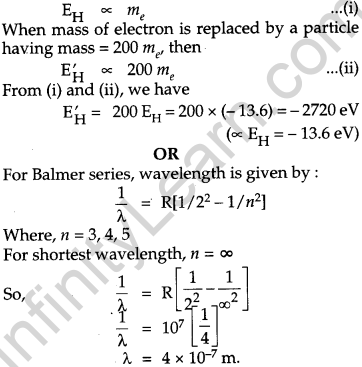
Question 10.
A battery of emf 12 V and internal resistance 2 Ω is connected to a 4 Ω resistor as shown in the figure. [2]
(a) Show that a voltmeter when placed across the cell and across the resistor, in turn, gives the same reading.
(b) To record the voltage and the current in the circuit, why is voltmeter placed in parallel and ammeter in series in the circuit ?
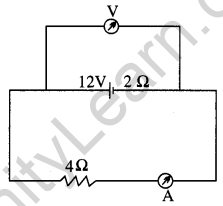
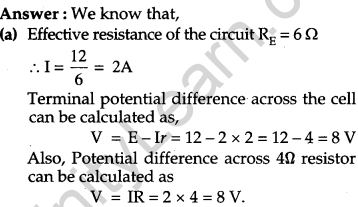
So, a voltmeter when placed across the cell and across the resistor, gives the same reading,
(b) An ammeter is connected in series because it has very low resistance. So, when, an ammeter is connected in series, then there is not much increase in the resistance of the circuit and hence the current through the circuit unchanged.
A voltmeter is connected in parallel because it has very high resistance. So, it draws a very small current from the circuit.
Section—C
Question 11.
Define an equipotential surface. Draw equipo- tential surfaces: [3]
(i) in the case of a single point charge and
(ii) in a constant electric field in Z-direction. Why the equipotential surfaces about a single charge are not equidistant ?
(iii) Can electric field exist tangential to an equipotential surface ? Give reason.
Answer: An equipotential surface is the surface which has same potential at its every point.
(i)
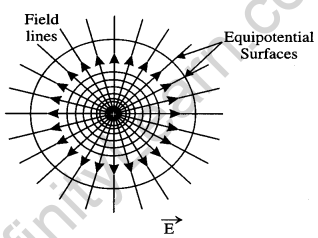
(ii)
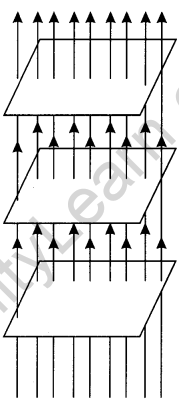
The electric field due to single charge is not constant, this is the reason why the equipotential surfaces about a single charge are not equidistant and potential vary
inversely with radius i.e., V × 1/r
(iii) No, electric field cannot exist tangential to an equipotential surface. If it happen then a charged particle will experience a force along the tangential line and can move along it. As a charged particle can move only due to the potential difference i.e., along the direction of charge of potential, this contradicts the concept of an equipotential surface.
Question 12.
(i) State law of Malus.
(ii) Draw a graph showing the variation of intensity (I) of polarised light transmitted by an analyser with angle (θ) between polariser and analyser.
(iii) What is the value of refractive index of a medium of polarising angle 60°? [3]
Answer :
(i) Malus discovered that when a beam of completely plane polarized light is passed through the analyser, the intensity T of transmitted light changes directly as the square of the cosine of the angle 0 between the transmission directions of polarizer and analyzer. This is known as the law of Malus.
I ∝ cos2 θ
I = I0 cos2 θ
Where, I0 is the maximum intensity of the transmitted light.
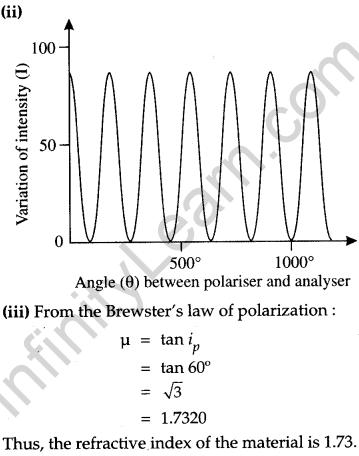
Question 13.
Sketch the graphs showing variation of stopping potential with frequency of incident radiations for two photosensitive materials A and B having threshold frequencies VA > VB. [3]
(i) In which case is the stopping potential more and why ?
(ii) Does the slope of the graph depend on the nature of the material used ? Explain.
Answer:
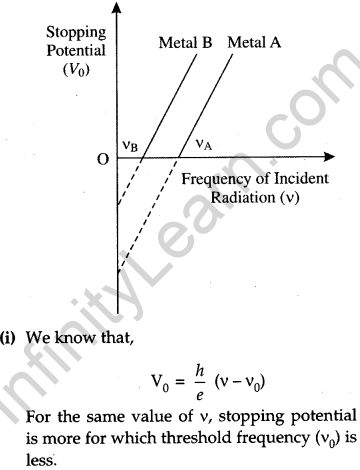
Given, VA > VB
Therefore, threshold frequency for metal B is less than the threshold frequency for metal A. Hence, stopping potential is more for metal B.
(ii) No, the slope of the graph tells us the value of h/e which is same for both the materials. So, it does not depend on the nature of the materials.
Question 14.
Write the basic nuclear process involved in the emission of β+ in a symbolic form, by a radioactive nucleus.
(b) In the reactions given below:
\(\text { (i) }_{6}^{11} \mathrm{C} \longrightarrow_{y}^{z} \mathbf{B}+x+v\)
\(\text { (ii) } \frac{12}{6} \mathrm{C}+\frac{12}{6} \mathrm{C} \longrightarrow_{a}^{20} \mathrm{Ne}+_{b}^{c} \mathrm{He}\)
Find the value of x,y,z and a,b,c. [3]
Answer:
(a) In β+ -decay, the atomic number of the radioactive nucleus decreases by one and its mass number remains same. In this process, a positron (e+) and a new particle neutrino (v) are emitted from the nucleus.
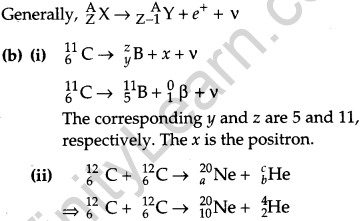
The corresponding values of a,b,c are 10,2 and 4, respectively.
Question 15.
(i) Derive an expression for drift velocity of free electrons.
(ii) How does drift velocity of electrons in a metallic conductor vary with increase in temperature ? Explain. [3]
Answer :
(i) Consider a conductor in which an electric field E is produced. Let a free electron experience a force (-eE) in this electric field. So, the acceleration of free electron is
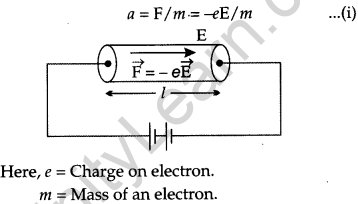
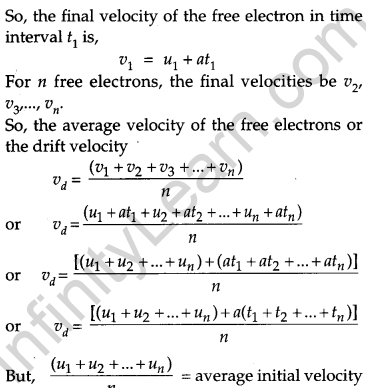
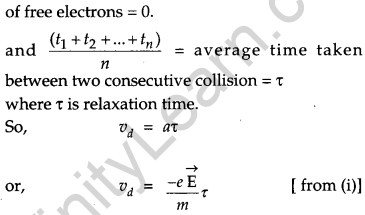
This is the required relation.
(ii) The drift velocity of free electrons in a metallic conductor decreases with increase in temperature, because, if we increase the temperature of the metallic conductor the collision between the electrons and ions increases, which decreases relaxation time. Hence, drift velocity decreases.
Question 16.
(i) When an AC source is connected to an ideal inductor show that the average power supplied by the source over a complete cycle is zero.
(ii) A lamp is connected in series with an inductor and an AC source. What happens to the brightness of the lamp when the key is plugged in and an iron rod is inserted inside the inductor ? Explain. [3]
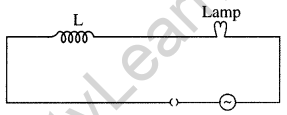
Answer:
(i) The average power supplied by the source over a complete cycle is
\(\mathrm{P}_{a v}=\mathrm{E}_{\mathrm{rms}} \mathrm{I}_{\mathrm{rms}} \cdot \cos \phi\)
When the circuit contains an ideal inductor, then the phase difference between the current and voltage is π/2.
So, \(\phi=\pi / 2 . \text { So, } \cos \phi=\cos \pi / 2=0\)
Hence \(\mathrm{P}_{a v}=0\)
So, when an ac source is connected to an ideal inductor, the average power supplied by the source over a complete cycle is zero.
(ii) The brightness of the lamp will decrease. When the key is plugged in and the iron rod is inserted inside the inductor, it increases the inductance. Hence, the reactance of the inductor (XL = ωL) increases. So, the impedance of the circuit (Z = R + jωL) increases, which decreases the current in the circuit.
Question 17.
(i) Explain with the help of a diagram the formation of depletion region and barrier potential in a p-n junction.
(ii) Draw the circuit diagram of a half wave rectifier and explain its working. [3]
Answer :
(i) During the formation of p-n junction, the holes diffuse from p-type semiconductor to the n-type, and electrons diffuse from n-type to p-type. This is because of the concentration gradient across p-side and n-side.
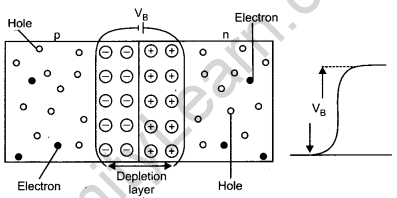
When a hole diffuse from p to n type, it leaves an unmovable negative charge. Similarly, when an electron diffuses from n to p type, it leaves an unmovable positive charge. When the diffusion of holes and electrons takes place continuously across the junction, a layer of unmovable positive and negative charges are developed on either side of the junction. This layer is called the depletion layer or the depletion region and the potential difference across the region is called barrier potential.
(ii) Half wave rectifier:
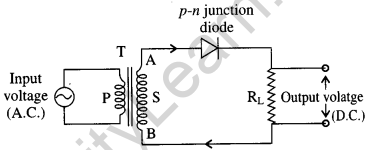
Working: When an input ac voltage is applied across the primary coil, a potential difference is developed across the ends of the secondary coil. Consider that in half cycle of input ac signal, the end A acts as the +ve end and B acts as the -ve end of the battery. So, the diode is in forward bias and we get output across the ends of the load resistance RL.
In the second half cycle, ends A and B reverse in polarity. Now, A acts as the -ve end and B acts as the +ve end. So, the diode D is in reverse bias and no output is obtained due to the high resistance offered by the diode.
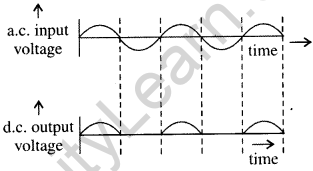
So, in this process, we get output alternately, and hence the diode is called the half wave rectifier.
Question 18.
(i) Which mode of propagation is used by short wave broadcast service having frequency range from a few MHz up to 30 MHz ? Explain diagrammatically how long distance communication can be achieved, by this mode.
(ii) Why is there an upper limit to frequency of waves used in this mode ? [3]
Question 19.
(i) Identify the part of the electromagnetic spectrum which is:
(a) suitable for radar system used in aircraft navigation,
(b) produced by bombarding a metal target by high speed electron.
(ii) Why does a galvanometer show a momentary deflection at the time of charging or discharging a capacitor ? Write the necessary expression to explain this observation. [3]
Answer :
(i) (a) Microwaves,
(b) X-rays
(ii) During the charging and discharging of a capacitor, a flow of charges take place from the battery to the plates of the capacitor. This produces a conduction current in the circuit and a displacement current between plates. Hence the galvanometer shows a momentary deflection.
\(\int \mathrm{B} \cdot d l=\mu_{0} \mathrm{I}+\mathrm{I}_{d}\)
Where \(\mathrm{I}_{d}=\frac{\varepsilon_{0} d \phi_{E}}{d t}\)
Question 20.
For a CE – transistor amplifier, the audio signal voltage across the collector resistance of 2 kΩ is 2 V. Suppose the current amplification factor of the transistor is 100, find the input signal voltage and base current, if the base resistance is 1 kΩ . [3]
Question 21.
Define the term wave front. State Huygens’s principle. Consider a plane wave front incident on a thin convex lens. Draw a proper diagram to show how the incident wave front traverses through the lens and after refraction focuses on the focal point of the lens, giving the shape of the emergent wave front. [3]
OR
Explain the following, giving reasons :
(i) When monochromatic light is incident on a surface separating two media, the reflected and refracted light both have the same frequency as the incident frequency.
(ii) When light travels from a rarer to a denser medium, the speed decreases. Does this decrease in speed imply a reduction in the energy carried by the wave ?
(iii) In the wave picture of light, intensity of light is determined by the square of the amplitude of the wave. What determines the intensity in the photon picture of light ?
Answer :
Wave front: A wave front is the locus of all the points in space that reach a particular distance by a propagating wave in same phase at any instant.
Huygens’s principle : It is based on two assumptions :
(a) Each point of the wave front behaves like a source of secondary disturbances and secondary wavelets from there points spread out in all directions with the same speed as that of the original wave front.
(b) When we draw an envelope in the forward direction of the secondary disturbances at any instant, And this envelope tells the new position of the wave front at that instant.
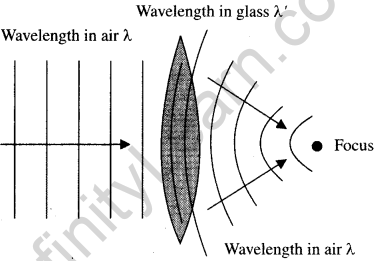
(i) Both the reflection and refraction takes place due to the interaction of light with the atoms at the surface of the separation. Light incident on these atoms, force them to vibrate with the frequency of light. But, the light emitted by these charged atoms is equal to their own frequency of oscillation. So, both the reflected and refracted lights have same frequency, hence frequency remains changed.
(ii) The energy carried by a wave depends on the amplitude of the wave. It does not depend on the speed of the wave propagation. Hence the energy of the wave remains same and does not decrease.
(iii) The intensity of light is determined by the number of photons incident per unit area around the point at which intensity is to be determined.
Question 22.
Use Biot-Savart law to derive the expression for the magnetic field on the axis of a current carrying circular loop of radius R.
Draw the magnetic field lines due to a circular wire carrying current I. [3]
Answer:
Imagine a circular coil of radius R with center O. Let the current flowing through the circular loop be I. Suppose P is any point on the axis at a distance of r from the center O. Let the circular coil be made up of a large number of small elements of current, each having a length of dl.
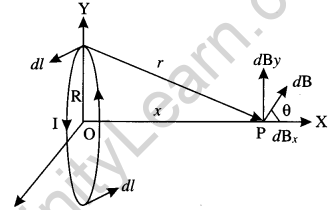
According to biot-savart’s law magnetic field at point P will be
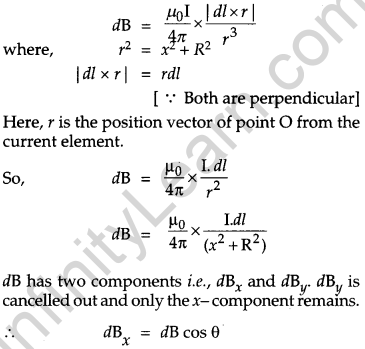
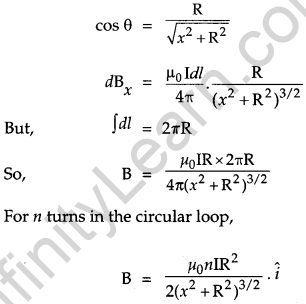
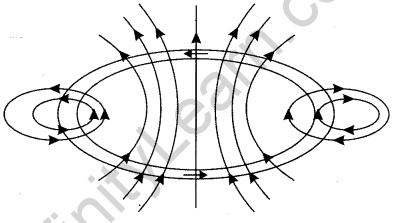
Section – D
Question 23.
Ram is a student of class x in a village school. His uncle gifted him a bicycle with a dynamo fitted in it. He was very excited to get it. While cycling during night, he could light the bulb and see the objects on the road. He, however, did not know how this device works. He asked this question to his teacher. The teacher considered it an opportunity to explain the working to the whole class.
Answer the following questions : [4]
(a) State the principle and working of a dynamo.
(b) Write two values each displayed by Ram and his school teacher.
Answer:
(a) A dynamo works on the principle of electromagnetic induction. A dynamo includes a coil attached to a small turbine fitted with a plastic cap. The coil is placed in a magnetic field. When the plastic cap comes in contact with moving tyres of the bicycle, the coil placed between the poles of a magnet rotates, thus, the flux through the coil changes continuously. This induces a current in the coil which is connected to a bulb which lights up. As long as the bicycle is moving, the coil keeps on rotating, and hence, the flux keeps on changing. At a steady rate, we get a steady current and hence a light of steady intensity is obtained.
Section—E
Question 24.
(i) Draw a labelled diagram of a step-down trans former. State the principle of its working.
(ii) Express the turns ratio in terms of voltages.
(iii) Find the ratio of primary and secondary currents in terms of turns ratio in an ideal transformer.
(iv) How much current is drawn by the primary of a transformer connected to 220 V supply when it delivers power to a 110 V— 550 W refrigerator ? [5]
OR
(a) Explain the meaning of the term mutual inductance. Consider two concentric circular coils, one of radius and the other of radius r2 (r1 < r2) placed co axially with centers coinciding with each other. Obtain the expression for the mutual inductance of the arrangement.
(b) A rectangular coil of area A, having number of turns N is rotated at ‘f revolutions per second in a uniform magnetic field B, the field being perpendicular to the coil. Prove that the maximum emf induced in the coil is 2 πf/NBA.
Answer:
(i)
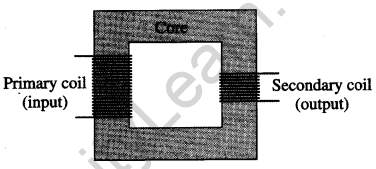
Principle : A transformer works on the principle of mutual induction. Whenever the amount of magnetic flux linked with a coil changes, an emf is induced in the neighboring coil.
Working: When an alternating current source is connected to the ends of primary coil, the current changes continuously in the primary coil, due to which magnetic flux linked with the secondary coil changes continuously. Therefore, the alternating emf of same frequency is developed across the secondary terminals. According to Faraday’s laws the e.m.f. induced in the primary coil,
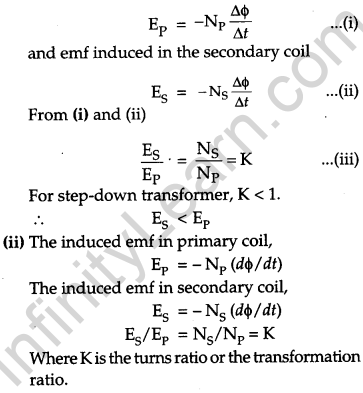
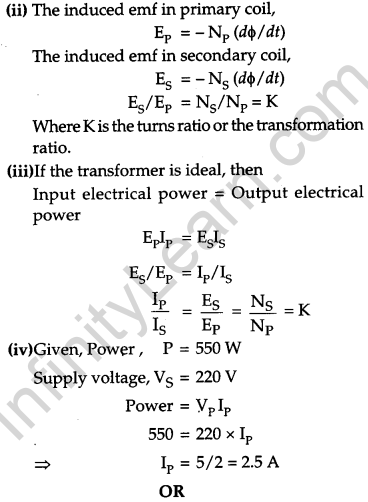
(a) Mutual inductance: It is the property of a pair of coils due to which an e.m.f. is induced in one coil due to the change in the flux or current in the other coil. Let a current I2 flow through the outer circular coil. The magnetic field at the center of the coil is \(\mathrm{B}_{2}=\frac{\mu_{0} \mathrm{I}_{2}}{2 r_{2}}\) …… (i)
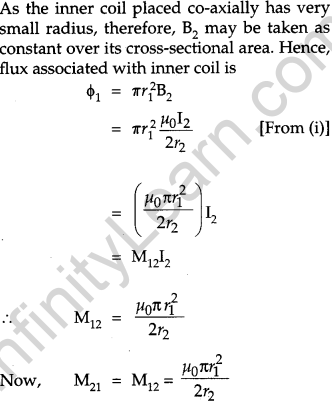
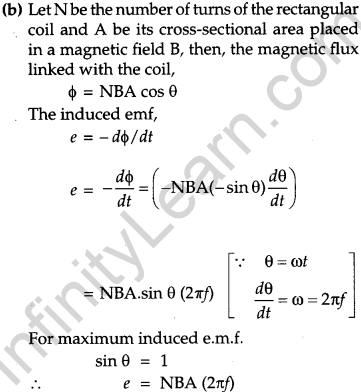
Question 25.
(a) Derive the mathematical relation between refractive indices n1 and n2 of two media and radius of curvature R for refraction at a convex spherical surface. Consider the object to be a point since lying on the principle axis in rarer medium of refractive index n1 and a real image formed in the denser medium of refractive index n2. Hence, derive Lens Maker’s formula.
(b) Light from a point source in air falls on a convex spherical glass surface of refractive index 1.5 and radius of curvature 20 cm. The distance of light source from the glass surface is 100 cm. At what position is the image formed ? [5]
OR
(a) Draw a labelled ray diagram to obtain the real image formed by an astronomical telescope in normal adjustment position. Define its magnifying power.
(b) You are given three lenses of power 0.5 D, 4 D and 10 D to design a telescope.
(i) Which lenses should be used as objective and eyepiece ? Justify your answer.
(ii) Why is the aperture of the objective preferred to be large ?
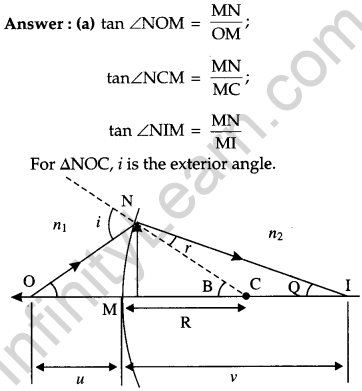
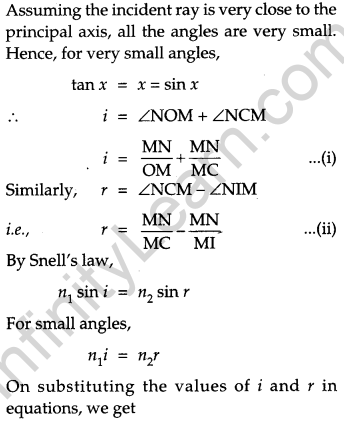
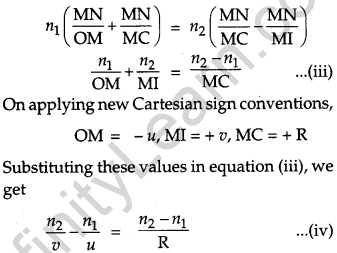
In deriving Lens maker’s formula, we adopt the coordinate geometry sign convention and make the assumptions:
(i) The lens is thin so that the distances measured from the poles of its two surfaces can be taken as equal to the distances from its optical center.
(ii) The aperture of the lens is small.
(iii) The object is a point-object placed on the principal axis of the lens.
(iv) The incident and the refracted rays make small angles with the principal axis.
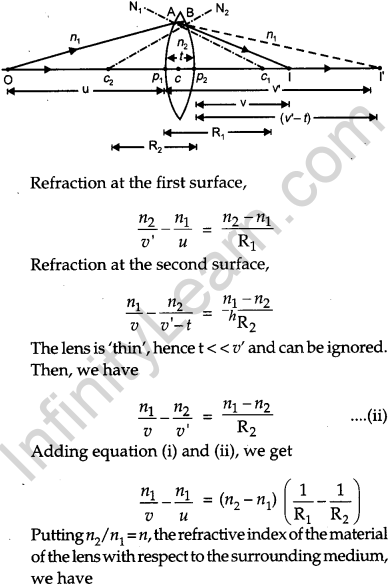
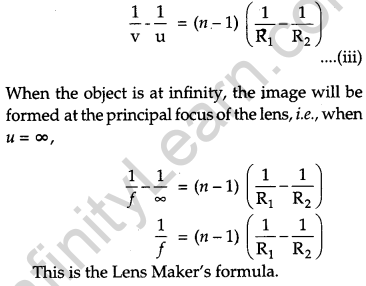
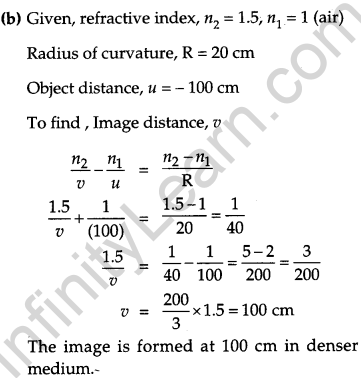
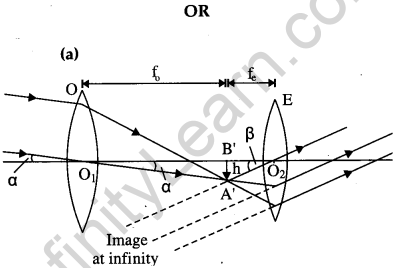
Magnifying power : The magnifying power of a refracting type astronomical telescope is defined as the ratio of angle subtended by the final image at eye to the angle subtended by the object at eye.
(b) (i) We know that,
\(\text { Magnification, } m=\frac{f_{o}}{f_{e}}=\frac{P_{e}}{P_{o}}\)
Therefore, the lens of 0.5 D should be used as objective and the lens of 10 D should be used as eye-piece in order to achieve higher magnification.
(ii) The aperture of the objective lens is made larger so, that it receives as much light as coming from the distant object and the resolving power of the telescope increases.
Question 26.
(i) Use Gauss’s law to find the electric field due to a uniformly charged infinite plane sheet. What is the direction of field for positive and negative charge densities ?
(ii) Find the ratio of the potential differences that must be applied across the parallel and series combination of two capacitors C1 and C2 with their capacitance’s in the ratio 1:2 so that the energy stored in the two cases becomes the same. [5]
OR
(i) If two similar large plates, each of area A having surface charge densities +σ and – σ are separated by a distance in air, find the expressions for
(a) field at points between the two plates and on outer side of the plates. Specify the direction of the field in each case.
(b) the potential difference between the plates.
(c) the capacitance of the capacitor so formed.
(ii) Two metallic spheres of radii R and 2R are charged so that both of these have same surface charge density σ. If they are connected to each other with a conducting wire, in which direction will the charge flow and why ?
Answer: (i)
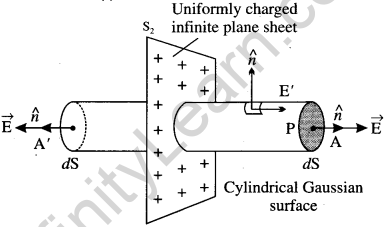
Consider a thin infinite uniformly charged plane sheet having the surface charge density of a. The electric field is normally outward to the plane sheet and is same in magnitude but opposite in direction. Now, draw a Gaussian surface in the form of cylinder around an axis. Let its cross-sectional area be A. The cylinder is made from three surfaces A, S2, and A and the electric flux linked with S2 is 0. So, the total electric flux linked through the Gaussian surface is
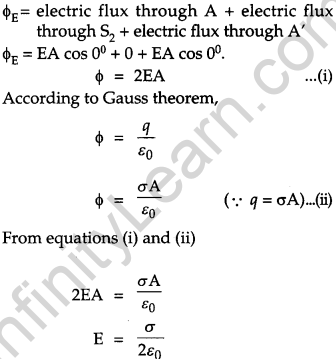
The direction of field for positive charge density is in outward direction away from sheet and perpendicular to the plane infinite sheet whereas for the negative charge density the direction becomes inward i.e., towards the sheet and perpendicular to the sheet.
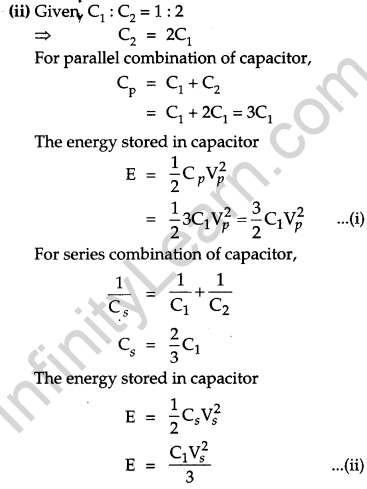
Equating equation (i) and (ii), since energy stored in both cases are same we get,
\(\begin{aligned} \frac{3}{2} \mathrm{C}_{1} \mathrm{V}_{p}^{2} &=\frac{\mathrm{C}_{1} \mathrm{V}_{s}^{2}}{3} \\ \frac{\mathrm{V}_{p}}{\mathrm{V}_{s}} &=\frac{\sqrt{2}}{3} \end{aligned}\)
OR
(i) (a) Consider a parallel plate capacitor with ‘ two identical plates X and Y, each having an area of A, and separated by a distance d. Let the space between the plates be filled by a dielectric medium with its dielectric constant as K and σ be the surface charge density on each of the plates.
Surface charge
